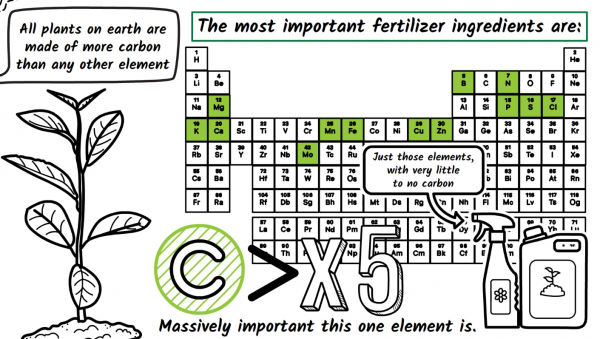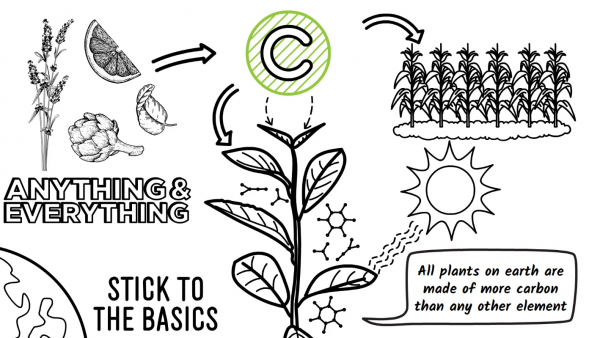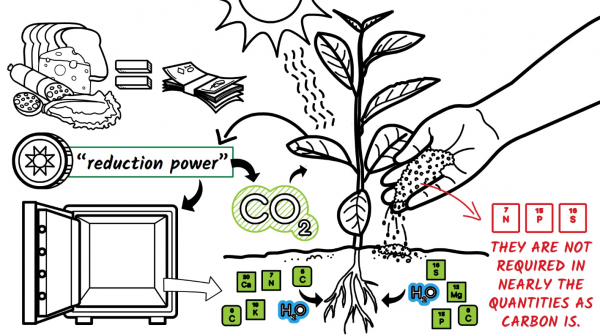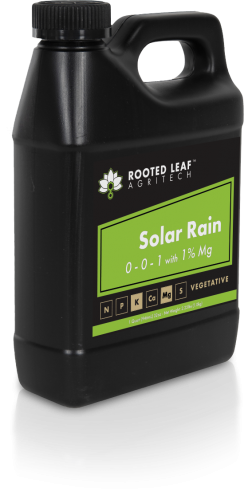It’s All About Carbon
Even though this is our first article, it’s been a long time in the making. We’ve been thinking for a while now about how to introduce some of the concepts that went into engineering the Rooted Leaf product line because so many of our customers are intrigued by what’s in the bottles. Ever since we first launched our products, we’ve been hearing a lot of positive feedback and we’re quickly getting to a point now where we’re getting so many questions like “what’s in Solar Rain that makes my plants grow so vigorously?” that it makes sense for us to come up with a series of articles that will help our customers better understand what’s in their favorite Rooted Leaf product.
What comes to mind when you think of “plant nutrition” and “fertilizers”? For most people, the first thoughts are something along the lines of “NPK, CalMag, and micronutrients” – but the irony is that these elements collectively make up less than 10% of the composition of most plants. Whether they know it or not, all farmers strive to sink as much carbon into their plants as they can.

In this article, we will look at how carbon plays a key role in determining yield and quality, and how it has been largely overlooked in conventional and mainstream agricultural fertility programs. A good place to start is with some basic biochemistry and common practices, so that we can better understand the concept of carbon as a macronutrient.
All aspects of plant nutrition and fertility revolve around carbon. Carbon is anything and everything to a plant – the zest of orange peels, the hue of lavender buds, the sweetness of licorice roots, the fiber in artichoke hearts – if it is something that a plant makes, then it is going to have carbon in it… and yes, this includes terpenes, phenolics, and other pharmacologically active compounds.
A carbon-based approach to achieving higher yield and quality is more mechanical than it is esoteric, and there are not a lot of moving parts so we can keep it simple. First: most of the pharmacologically active compounds produced by plants, such as terpenes, can be up to 90% carbon by weight. Being that they are predominantly carbon, it is the availability of carbon that is often times a limiting factor for the production of more of these compounds.

There is no NPK in a molecule of CBD. If you want more CBD, you need more carbon. If you do not supplement carbon through the roots, it has to be supplemented in the air, which is not the most efficient way of loading carbon into a plant, despite it being the most common method used in controlled environments and for high-value crops.
CO2 injection in sealed rooms results in increased growth, yield, and quality because the added carbon load provides the plants with additional building blocks, and acts as a buffer against stressors. As the carbon load goes up, so too does a plants ability to tolerate higher light intensity and fertilizer levels, and this is why commercial growers who add carbon in the form of CO2 can push their plants harder and grow them in more demanding environments.
Ironically, all of the usual elements that come to mind when we think of “plant fertilizer” – NPK, CalMag, etc. – are actually just tools that plants use to capture more carbon from the environment. For example, most of the nitrogen you put on your plants is going to end up being a constituent of either an enzyme called Rubisco or the well-known pigment that gives plants their green color – chlorophyll. Rubisco is one of the most abundant enzymes on earth, and it only has one job: to capture carbon out of the air. Chlorophyll is not far behind Rubisco in terms of abundancy on this planet, and it too plays a key role in capturing carbon.

Here again, you can see the simple mechanics of our carbon-based approach: most of the nitrogen you apply to your plants will ultimately be used to capture, store, and utilize more carbon. The same thing is true with phosphorus, potassium, calcium, magnesium, silicon, and even water. Pretty much everything a plant does revolves around carbon. It is required in significantly larger amounts than any other individual element, easily four times more than the combination of all of the elements which are collectively thought of as macro and micronutrients.
Although the concept of carbon-based nutrition is still new for most farmers across all agricultural industries, it is one of the most important and should not be overlooked. Farmers who are looking to improve their yields and quality are going to eventually come around to the realization that it is all about carbon – sinking more carbon into your grapes, hops, potatoes, and tomatoes is going to allow you to pull out more brix, alpha-acids, starches, and sugars back out.
You reap what you sow.
Learn More!
Experience the Rooted Leaf!

Solar Rain
0 - 0 - 1 with 1% Mg and 12% Carbon
Solar Rain is derived from: Fermented plant material (Camellia sinensis, Carthamus tinctorius), magnesium fulvate, magnesium citrate, magnesium acetate, and potassium citrate.





